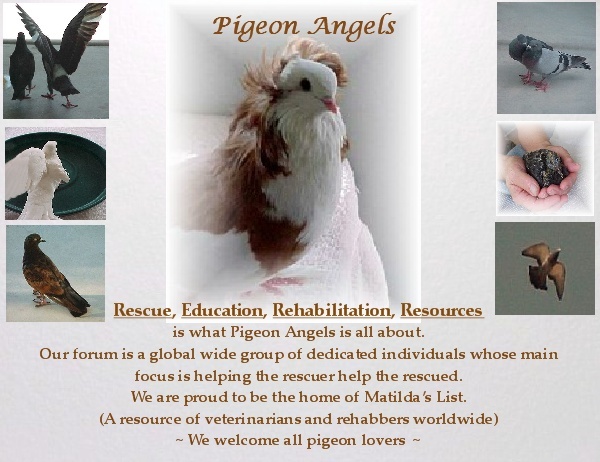AVIAN MYTH BUSTERS -- Time to clear up some myths
By Dr. Colin Walker B.Sc. B.V.Sc. M.A.C.V.S (avian health)
Myth 1.
‘Air sac disease’ can be diagnosed in the droppings:
Microscopic examination of droppings is a useful diagnostic step but it is important that fanciers realize this test’s limitations. Last week at the clinic we had an unusual situation. We had a fancier ask us to diagnose if his birds had air sac disease (ie. an infection of the air sacs) by examining his birds droppings. He seemed to think this was quite possible and stated that this had been done elsewhere. Let me state here quite categorically that this is just not possible.
In the droppings we can diagnose parasitic problems such as worms and coccidia and in very fresh samples Hexamita. We can also get an impression (particularly with special stains) of the bacteria present and also detect the presence of yeasts. If the birds are not well, for any reason, so that their ability to resist disease is reduced, bacteria capable of causing disease will take advantage of this, increase in number and the bacterial population in the bowel will change. Any health problem (and included in this list is air sac disease) or indeed any management or environmental error (eg cold damp loft, poor diet, over tossing) can lead to these changes. Any vet who examines droppings microscopically and based on this, diagnoses air sac disease is just not being honest. And if a vet suggests that antibiotics for this condition should commence after only doing this test, lets face it, it’s time to get a new vet. The two principal causes of respiratory infection in pigeons are Chlamydophila and Mycoplasma. Chlamydophila is diagnosed usually in a live bird either by a Chlamydia immunocomb test (which detects Chlamydia antibodies in the blood stream, costs about $50.00 and takes about 5 hours to do }or alternatively a Chlamydia PCR (that measures Chlamydia DNA in the blood stream, costs about $40.00 and takes about 10 days to do). With Mycoplasma, although symptoms displayed by the birds and changes visible on microscopic examination of a throat swab may be suggestive, usually an autopsy combined with histopathology (microscopic examination of tissues) is required.
Myth 2.
‘Fungal problems in grain can be detected by simply culturing the grain’
When grain is cultured for fungi the fungal spores on the grain will grow and the grain will go mouldy. This does not necessarily mean the grain is bad and condemning the grain based on this test is simply not correct. The test is just not valid. Mould spores (the fungal equivalent of a seed) are quite commonly found in samples of grains and legumes and occur naturally in these samples. Often the mould is present as inert spores that would not become active unless they come in contact with moisture. The presence of mould in itself is not the important factor but whether or not the mould has been active and is of a species that would give rise to fungal toxins (called mycotoxins). To measure mycotoxin levels is a laboratory procedure. Expect to pay about $100.00 for this test or ask your local grain merchant whether the grain he is supplying has had this test. If any one offers to test grain for a lower amount simply ask yourself why is it so cheap. Probably the grain is simply being cultured and the results are just not of any real use to you. If fanciers need further information I suggest you contact the experts at Agrifood on 1800 801 312. Ask to speak to Don Patterson.
Myth 3.
‘That Streptococcus (a bacteria) can be diagnosed by microscopic examination of droppings or culturing of droppings’
This one is a beauty. Streptococcus is regarded as a normal inhabitant of the bowel in pigeons. It is therefore found in the droppings of both healthy and sick birds. Finding it in the droppings therefore means nothing. Any vet who finds it here and diagnoses your birds as having Streptococcus infection is simply ‘pulling your leg’. Streptococcus can cause disease however it only becomes a problem when it invades the bowel wall (leading to a green watery diarrhea) or enters the blood stream. Once in the blood stream it can infect a variety of sites. To diagnose Streptococcus one needs to therefore identify the bacteria elsewhere in the body (ie. not in the bowel) or associate it directly with bowel wall inflammation.
Correct diagnosis leads to the correct medication being supplied and an understanding of the biology of the current problem. This means we know how the problem came about and what measures we need to adopt to prevent it happening again. Incorrect diagnosis leads to inappropriate use (usually overuse) of medication and an inability to understand the current problem properly.
Assess the advice you are given. If your birds become unwell don’t ask the old fella at the club, your neighbour or your mate. Your local veterinarian will be helpful but often the best person to contact is a fully qualified avian veterinarian. There are currently approximately 24 avian vets available throughout Australia. Victoria has 4, Queensland has 7, and New South Wales has 8. If fanciers wish to contact me at the clinic I can always put them in touch with their closest one.


